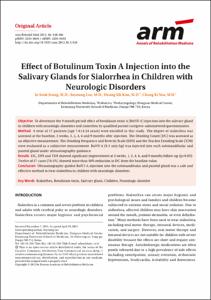KUMEL Repository
1. Journal Papers (연구논문)
1. School of Medicine (의과대학)
Dept. of Rehabilitation Medicine (재활의학)
Effect of Botulinum Toxin A Injection into the Salivary Glands for Sialorrhea in Children with Neurologic Disorders
- Keimyung Author(s)
- Lee, So Young; Kim, Heung Sik; Yeo, Chang Ki
- Department
- Dept. of Rehabilitation Medicine (재활의학)
Dept. of Pediatrics (소아청소년학)
Dept. of Otorhinolaryngology (이비인후과학)
- Journal Title
- Annals of Rehabilitation Medicine
- Issued Date
- 2012
- Volume
- 36
- Issue
- 3
- Abstract
- Objective To determine the 9 month period eff ect of botulinum toxin A (BoNT-A) injection into the salivary gland
in children with neurologic disorders and sialorrhea by qualifi ed parent/caregiver-administered questionnaires.
Method A total of 17 patients (age 7.6±4.24 years) were enrolled in this study. The degree of sialorrhea was
assessed at the baseline, 2 weeks, 1, 2, 4, 6 and 9 months after injection. Th e Drooling Count (DC) was assessed as
an objective measurement. Th e Drooling Frequency and Severity Scale (DFS) and the Teacher Drooling Scale (TDS)
were evaluated as a subjective measurement. BoNT-A (0.5 unit/kg) was injected into each submandibular and
parotid gland under ultrasonography-guidance.
Results DC, DFS and TDS showed signifi cant improvement at 2 weeks, 1, 2, 4, 6, and 9 months follow-up (p<0.05).
Twelve of 17 cases (70.5%) showed more than 50% reduction in DC from the baseline value.
Conclusion Ultrasonography-guided BoNT-A injection into the submandibular and parotid gland was a safe and
eff ective method to treat sialorrhea in children with neurologic disorders.
Key Words Sialorrhea, Botulinum toxin, Salivary gland, Children, Neurologic disorder
- Publisher
- School of Medicine
- Citation
- In Seuk Jeung et al. (2012). Effect of Botulinum Toxin A Injection into the Salivary Glands for Sialorrhea in Children with Neurologic Disorders. Annals of Rehabilitation Medicine, 36(3), 340–346. doi: 10.5535/arm.2012.36.3.340
- Type
- Article
- ISSN
- 2234-0645
- 파일 목록
-
-
Download
 oak-aaa-00314.pdf
기타 데이터 / 169.5 kB / Adobe PDF
oak-aaa-00314.pdf
기타 데이터 / 169.5 kB / Adobe PDF
-
Items in Repository are protected by copyright, with all rights reserved, unless otherwise indicated.